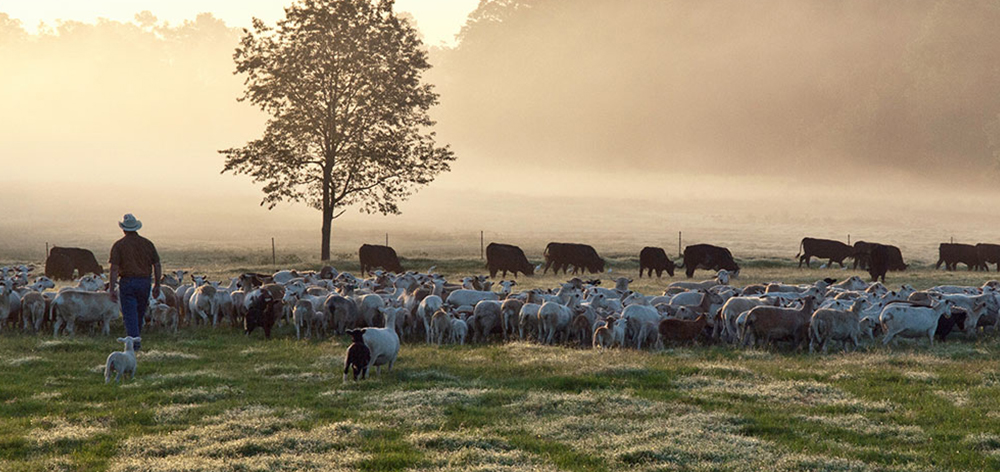Is fake meat really as sustainable as it seems?
Like most people today, I think a lot about tomorrow’s world I want to give to my children and to the next generations to come.
All human activities have a share of responsibility. The meat industry is particularly singled out. Consumers seek to reduce or even stop consuming meat in the belief that they are doing the right thing, and so they look for other sources of protein, which is essential to the human body (an interesting fact is that 84% of people who try a vegan diet return to a meat-based diet for obvious reasons). However, little is said about the real cost of plant-based protein production and its impact on the land, the soil, and the planet earth as a whole.
Do you really know how much “fake meat” costs to our planet?
Recently, our North American team had the privilege of visiting White Oak Pastures who transitioned away from industrial agriculture techniques and began operating the farm as a living ecosystem for more than two decades.
White Oak Pastures has been a leader in illuminating the role meat production plays in climate change for years.
“Industrial mono-crop agriculture such as soy or peas is essential to produce the ingredients for plant-based proteins” White Oak Pastures Owner Will Harris explains. However, industrial mono-crop agriculture utilizes tillage, chemical fertilizer, and pesticides which harm the environment by degrading the soil, killing off microorganisms, allowing the topsoil to erode, causing flooding, releasing greenhouse gases, leaching chemicals into streams, rivers and eventually oceans. In addition, rural lands and communities around the world are “impoverished by this system of land management. It is one of the greatest tragedies of the 20th century,” tells Harris on one of his recent blog articles.
The benefits of regenerative grazing
For Will Harris plant-based proteins, also called “fake meat” is not benefiting future generations and are contributing to climate change while grass-fed cattle help reverse it.
Just to be clear. “Beef industry” includes a wide range of farming practices. White Oak Pastures grass-fed beef does not share the stigma of extremely high greenhouse gas emissions attached to conventional beef. Most of the debate has been about measuring the environmental impact of massive feedlot cattle operations – and there are disagreements within the cattle industry itself.
Will Harris explains that grazing ruminant populations are essential for a healthy ecosystem. The Savory Institute, a leader in the field of regenerative agriculture, lists multiple benefits of keeping cattle on pasture for their entire lives:
- restores soil microbial diversity
- makes the land more resilient to flooding and drought
- boosts the nutrient content and flavor of livestock and plants
- grasses trap atmospheric carbon dioxide to help fight climate change
- reduces water use by avoiding the need to irrigate cropland
- reduces fertilizer runoff polluting waterways
- reduces the concentration of manure from confined feeding operations
- reduces pesticide use on conventional cropland
- increased natural habitat
If you want to know more about rotational grazing, check out our recent article here. Here at Hustler, we believe in sustainable farming practices, in particular natural pasture grass-feeding, underpins our range of world-leading livestock feeding solutions. The benefits of natural grass-fed livestock are many – from happier, healthier animals and naturally fertilized paddocks through to better tasting meat and dairy. Subscribe to our newsletter to follow our latest tips for achieving sustainable farming practices.
Sustainable land management practices can offer carbon-negative beef
“At White Oak Pastures, we never believed that this simple input-output approach told the full story of the complex interactions between soil microbes, photosynthesis, plant roots, and grazing animals that allow carbon to be absorbed and stored in healthy soil,” Harris says.

In 2019, White Oak Pastures participate in a Life Cycle Assessment study designed to take factors such as soil health and carbon sequestration into consideration. Nobody denied the fact that industrially-farmed soy and pea protein-based products are net carbon emitters. In stark contrast, White Oak Pastures integrated system is six times more carbon efficient than North American average production systems.
The study also shows that at least 3.5 pounds (about 1.3 kilograms) of carbon being stored in White Oak Pastures’ soil for every pound of White Oak Pastures beef meat. In comparison, reports show how industrial farming of GMO-soy or peas for their meat substitute releases at least 3.5 lbs of carbon dioxide equivalent for every pound of fake meat that is consumed. “The irony is you’d have to eat almost exactly one pound of our grass-fed beef to offset the carbon emitted from eating a pound of their stuff made from commodity crops,” laughed Harris.
“Our 3,200-acre farm stores enough carbon in the soil to offset all the methane emissions from our grass-fed cattle, and most of the farm’s total emissions. While it is true that our cattle live for longer, producing more methane over their lifetimes, they are grazing on holistically-managed pasture that not only offsets their impact, it stores additional carbon. That means that with our holistic land management practices, we are producing carbon-negative beef,” concluded Harris.
I’d like to thank Will Harris to welcoming our team at White Oak Pastures and to working for tomorrow’s world with quality grass-fed beef.



























